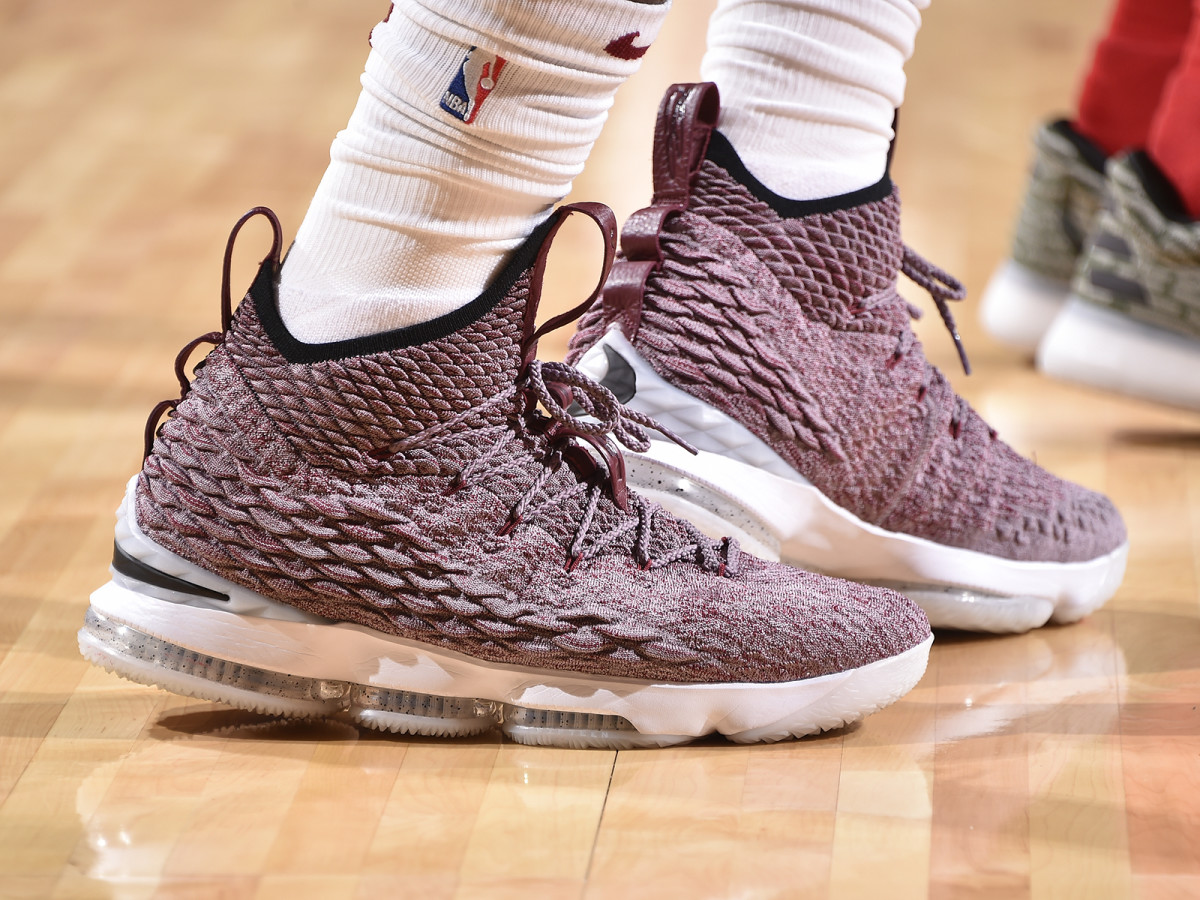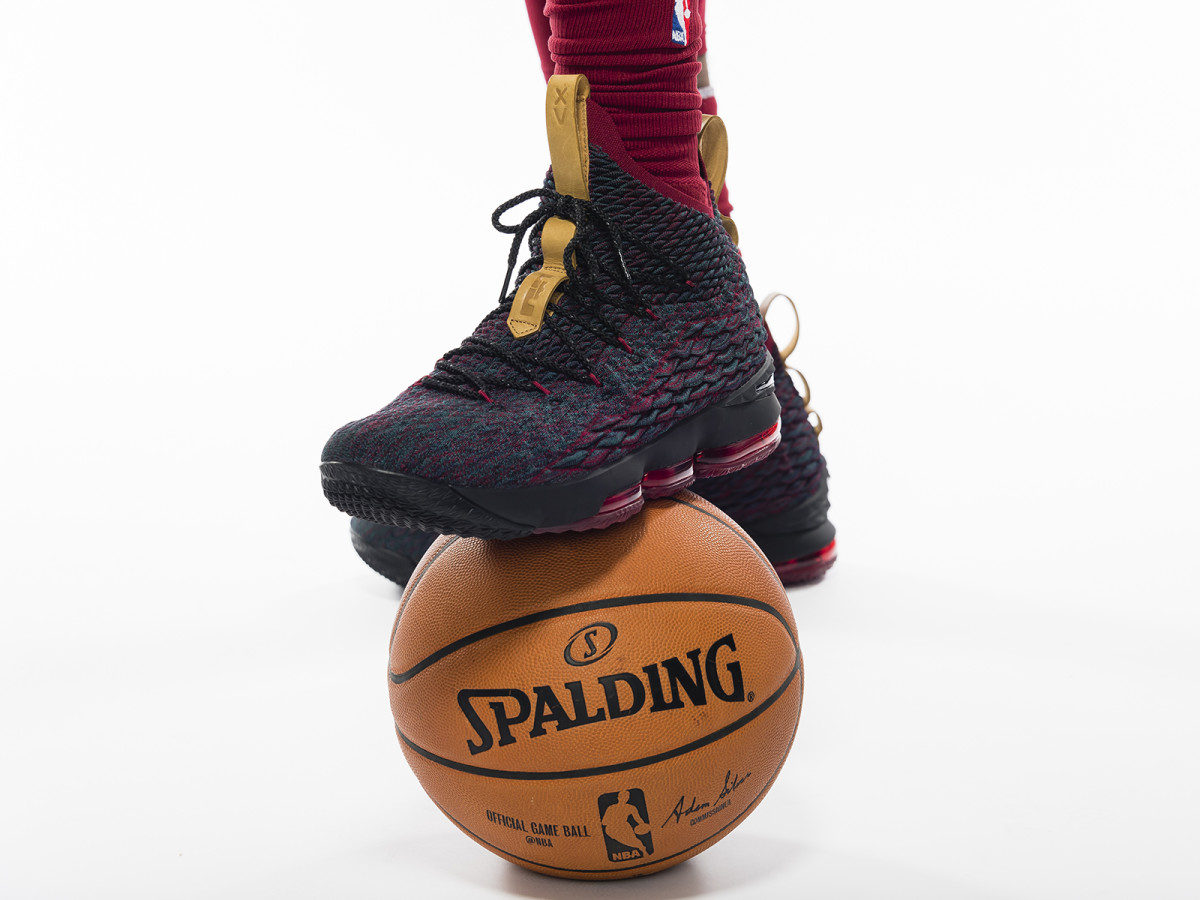A Deep Dive Inside the Creation of the LeBron 15

Tim Day knows what it is like to be in the trenches as an professional athlete. Before designing sneakers for NBA superstars such as LeBron James and Kevin Durant, Day, Nike's senior global product line manager, spent a couple seasons in the NFL as a tight end for the Bears, Eagles and Bengals.
Alongside Nike designer Jason Petrie, who has worked with LeBron for more than a decade, the two created James’ latest signature sneaker, the LeBron 15.
“I worked on the football side of things but knowing with my background and playing basketball, I wanted to be in the basketball category," Day said, "because if you ask anybody about basketball, it is the story engine I say for Nike. We have amazing athletes who have amazing stories. I have been in basketball for about a year and a half, specifically on LeBron, and it has been amazing man working with Jason Petrie and some other talent we have on the team. We literally call ourselves the Yankees of Nike because we have the best of the best.”
The Cavs Can Still be Fun When They Try
The LeBron 15 is the most advanced sneaker of the NBA superstar's career, featuring a flyknit upper Nike calls Battleknit. The new flyknit is something that has never been done with a performance basketball model. On the Road Tripping Podcast with Richard Jefferson and Channing Frye, LeBron discussed how special the 15 is for him.
“This one in particular is very special because this one, and if you consider the last three or four signature shoes, I would say we really hit a homerun on this one," LeBron said. "I think we hit some singles, we had some doubles, we had a couple triples in the last three or four years and I think we finally went up to the plate and hit a f*cking home run.”
The Crossover had the chance to chat with Day to go behind the design of the LeBron 15 and figure out how it could become a fashion staple off the court.

Jarrel Harris: Can you describe your experience working with LeBron and what it’s like rubbing shoulders with someone of that magnitude?
Tim Day: He made it easy man. He’s a really down to Earth dude. Every conversation is always great, you talk about number 15, he has a ton of background in building shoes, he can you tell you from top to bottom the components of every shoe which makes it easier for us. And you are talking about one of the greatest athletes ever, building shoes for somebody that is 6'8", 250 pounds that moves like him with so much force, it is the top of the spear, anything else would be going down. So it has been great.
JH: LeBron is one of the smartest athletes out there. How much insight does he provide when designing a sneaker?
TD: He gives a ton. As I mentioned before, this is number 15 so he knows the right insight to give. When he has a hot spot under his foot, when he is not getting the right containment, or if his game is going to a new place, which is from the 13, 14 and 15, he has given different insight. Specifically for the 15, he said, 'Hey I want to go back to the seven height,' so dropping the height down and getting more flexibility in the ankle and allowing him to move with more force. Insights like that help and allowed us to put the shoe in a different direction.
WATCH: Cavaliers Take The New York City Subway After Morning Shootaround
JH: LeBron is a freak of nature. So what are the challenges of building a sneaker for someone of his size?
TD: Well, the challenges are hard because you have to build a shoe for him but for everyone else as well. If you look at the 11 through the 13, a lot of people will say those models were a little bulky but for him they were perfect. So I think for the 15 he was looking at all the models that we have done before that and building a shoe for him and for everyone else.
JH: How did you start the process for creating the LeBron 15?
TD: We were already working on some innovation elements within the innovation kitchen at Nike and we knew that we wanted to take some of the lightest materials that we had and make them as strong as possible and put them into the shoe. So that's where we started with the knit upper. We took flyknit, one of our lightest technologies ever, and we said how do we make this the strongest for LeBron while keeping it true to knit and that is where we got BattleKnit from, taking flyknit and adding elements of it where LeBron needed it the most to make it work on the court for him. We really trust that innovation and we feel really good about it.
JH: What was the inspiration behind the LeBron 15?
TD: If you think about the scales of a dragon and shields, that was some of the inspiration behind it when we talk about protection, like giving the visual look of protection and then actually protecting your foot as well. When you talk to LeBron, the number one thing he mentions is protect me from myself because he is a freak of nature and he moves in ways sometimes he doesn't even know, so we have to do things that protect him but we want to give the visual look of protection as well. That’s why you see the scales and the areas where we added more knit depth so that it adds more protection.
JH: Can you dive into the tech and go over some of your favorite parts of the sneaker?
TD: For me it is the flyknit upper, when you talk about for this for LeBron—the high-fashioned, high function—we want to build a shoe that not only works on court but for $180-200 you better make sure it works off court as well. For LeBron, out of all of our guys he is probably the the easiest person to transit off court so he wants a shoe on court that looks great that he can style in different ways and put it in different colors, so for me it is the upper knit. The knit is beautiful, it speaks to protection in regards to the scales and the areas we put it but when you color it up with different multi-colors even if you do a single-knit color it looks amazing.
JH: The Swoosh is on the back heel, which is not common in Nike designs. What was the reasoning behind that?
TD: Yes, that was actually a process. You know Nike we put big swooshes on shoes, but when we were out shopping, specifically in New York, even in the Bay Area, the feedback was like why don't you guys put the swoosh in the heel and let the knit live. The knit is beautiful, you guys have done a good job of making it feel different than the normal flyknit you see on the running or training shoes. So putting a Nike Swoosh on it would have made it feel like a Hypderdunk or something—which is nothing wrong with the Hyperdunk since that is not LeBron's signature shoe—so we actually took the Swoosh, put it on the heel and made it still visible. We let the knit breathe and let it be beautiful the way that it is.

JH: How do you see the basketball sneaker industry now? Are designers striving to make more lifestyle models or is there heavy focus still on performance? How hard is it to balance the two?
TD: So when we briefed the shoe we actually briefed it as from a performance and a style side as well. When you look at at the style side, it is actually how the shoe is built. So looking at the toe shape, it looks narrow like an actual lifestyle shoe. When you look at it from a lateral view, the sidewalls are a little bit lower. The shoe looks sleek. And that's what we got with the knit once you give that sock-like fit. So just like LeBron, he is super-tapered with everything that he wears on his body, we wanted the shoe to taper his foot and look super clean. And with knit we knew we would get the performance benefit but with style as well.
Have A First Look At The KITH x LeBron 15 Zip In Floral https://t.co/QneC5dd2H5 pic.twitter.com/1D97fssGhS
— 93 Till Infinity Media (@planet_aviation) September 11, 2017
JH: The LeBron 15 was introduced at the KITH Fashion Show by Ronnie Fieg. How did that partnership come together?
TD: A big one for us was how do you take someone that is heavy in culture like LeBron and start there and let it transit there. When we look at partnerships we knew there was a natural connection between LeBron and Ronnie. We know where the KITH brand is going and we felt that was a good spike in the road for us to meet to bring this into culture first before we brought unto court. So we collabed with them, and if you think about Ronnie and some of the things he has done in the past, he pushes things very hard. So we knew the fashion show was a good place to be able to drop that out.
That has never been done before with a performance shoe being launched on a fashion show runway, so I think working with those guys back and forth we wanted to take the actual game shoe and dimensionalize it by adding the zipper, allowing you to zip it down and allow you to add some elements that can speak to culture and style off court. Even the version we did with the straps that go all the way around, we just wanted to push and do something different. And for the consumer who just wants to hoop in the shoe, we have that performance aspect as well, which we are going to go deep in.
The ‘Can You Not?’ Guy Who LeBron Annoyed Had No Idea He Was on the Subway with the Cavs
JH: LeBron is known to wear some crazy colorways, so what can we expect to see from the LeBron 15?
TD: It is going to be crazy. You have seen "Ghost" and you have seen "Ashes" and that is probably the simplest colorways we will do out of the batch. But we have some stuff that is going to blow people's minds
JH: Where does LeBron's signature line rank now?
TD: I mean, he is at the top. This is his 15th shoe, the only person that has that many is Jordan. If you compared the two, and a lot of people have been doing that a lot lately on court, but if you look at off-court some of LeBron's models from 1-10 and even where we are going with the 15, they push heavily in culture and they have created movements and that's what we wanted to do with the 15, even with the 16 and the 17 and some of the stuff we have coming out.
JH: How will you measure the success of the LeBron 15? Is it the sales? Is it how LeBron feels?
TD: It is a combination of all of it. I think the number one thing is going to be selling, because if you look at some of the models we had leading up to this one, they haven't done as well as we wanted. We did some heavy work with consumers and LeBron and we think the points that we missed on we caught them.
Obviously, looking at the stance of the shoe and how bulky it was as the culture moved within basketball shoes, they moved away from the bigger and bulkier shoes and we went back to a sleek shoe and some of the elements kids said that they missed and we feel like we have a home run. Obviously, it's going to be a lot on how we sell the shoe but we feel like the insight we got from it, the work that we did with LeBron and the work that we did with Kith, we're putting them back in the grace of sneaker culture.
